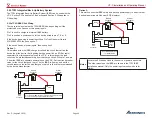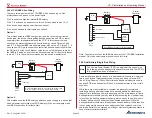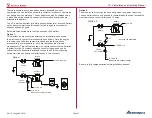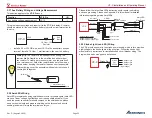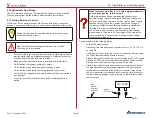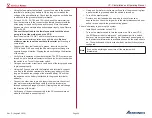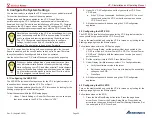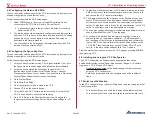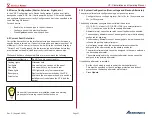
Page 63
VP-X Installation and Operating Manual
Rev. D (August 5, 2020)
7. Ground Test
The ground test steps are performed in two parts: the first part without the
engine running and the second part with the engine running.
7.1
Testing without engine running
Perform the following steps without the engine running. The battery will drain
during testing, so have either a charger or ground power available.
• With the master switch off, turn on the each backup circuit and verify
the respective device turns on. Turn off backup circuits.
• Turn on the master switch
• Verify that each of the switches turns on the expected devices. Wait
to test the alternator switches until the engine is running.
•
Verify the pilot flap switch operates as expected.
•
Verify the co-pilot flap switch operates as expected.
• Verify the pilot trim switches operate as expected.
• Verify the co-pilot trim switches operate as expected.
• Test the runaway trim system. If able, introduce opposite inputs from
the same stick or from both the pilot & co-pilot sticks (i.e. trim up
and down at the same time). Verify a fault after 3 seconds. Clear the
fault. Verify backup trim operation on the EFIS screen and reset fault.
Verify normal operation.
• Verify aux battery voltage display is correct (if installed)
• Turn off the master switch
7.2
Testing while engine running
This section verifies the proper operation of the VP-X with the engine
running. The main objectives for this section are:
• Verify engine starting and proper mag operation
• Verify starter annunciator
• Verify proper alternator operation
If this is coincident with first engine start, be sure to integrate the kit
manufacturer’s first engine start safety procedures with the test plan
specified herein. You may consider first verifying proper operation of the
engine and once that is complete, begin the electrical system test.
Prolonged low-power operation of a new engine may adversely affect the
engine. Be sure you understand the engine break-in requirements, and
balance those against the time needed to test the electrical system.
These procedures are published as a guideline. Follow the engine
manufacturer’s starting and safety procedures.
• Ensure that the battery is fully charged. If the voltage drops rapidly
during engine start, then the battery is bad or not fully charged.
• Start the engine and verify the starter circuit is operating correctly.
If the starter annunciator circuit is enabled, verify the starter
annunciator comes on during start.
• Note the bus voltage. Then turn on the primary alternator.
• The voltage should increase to 14.2 volts +/- 0.3 volts (check with
your alternator manufacturer for specifics)
• Turn off the primary alternator and note the bus voltage drop to about
12.5 volts.
• Run the engine up to about 1600 RPM and turn on the backup
alternator. The bus voltage should increase from about 12.3 volts to
about 14.0 volts.
• Turn off all the switches.

